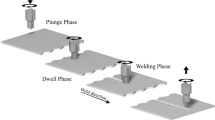Abstract
Traditional tools in friction stir welding (FSW) of thermoplastics fail to achieve high quality and strong welds. In this paper, a new heat-assisted stationary shoulder FSW tool design, which provides constant tool temperature during the process using a controllable hot air gun, is introduced. Effect of the process parameters, including tool temperature, rotational speed, and traverse speed, on the microstructure and mechanical properties of polypropylene sheets was investigated using Taguchi method and analysis of variance. Welded joints showed tensile strength up to 96% and elongation at break up to 99% of the base material. Samples with high mechanical performance showed a wider stir zone within thin flow layers, which arranged in a regular pattern, under polarized microscopy. Differential scanning calorimetry demonstrated that higher tool temperature results in lower degree of crystallinity. Scanning electron microscopy revealed that the sample with high mechanical properties has a craze-free fracture surface. However, the sample with the lowest mechanical properties produced a corrugated fracture surface full of crazes.












Similar content being viewed by others
Abbreviations
- PP:
-
Polypropylene
- FSW:
-
Friction stir welding
- HDPE:
-
High-density polyethylene
- ABS:
-
Acrylonitrile butadiene styrene
- RPM:
-
Rotation per minute
- DoE:
-
Design of experiment
- ANOVA:
-
Analysis of variance
- DSC:
-
Differential scanning calorimetry
- SEM:
-
Scanning electron microscope
References
Thomas WM, Nicholas ED, Needham JC, Murch MG, Templesmith P, Dawes CJ (1995) Friction welding (U.S. Patent 5,460,317)
Thomas WM, Staines DG, Norris IM, de Frias R (2003) Friction stir welding tools and developments. Weld World 47(11–12):10–17. https://doi.org/10.1007/BF03266403
Derazkola HA, Kashiry Fard R, Khodabakhshi F (2018) Effects of processing parameters on the characteristics of dissimilar friction-stir-welded joints between AA5058 aluminum alloy and PMMA polymer. Weld World 62(1):117–130. https://doi.org/10.1007/s40194-017-0517-y
Paoletti A, Lambiase F, Di Ilio A (2016) Analysis of forces and temperatures in friction spot stir welding of thermoplastic polymers. Int J Adv Manuf Technol 83(5–8):1395–1407. https://doi.org/10.1007/s00170-015-7669-y
Eslami S, Tavares PJ, Moreira P (2016) Friction stir welding tooling for polymers: review and prospects. Int J Adv Manuf Technol 50:1. https://doi.org/10.1007/s00170-016-9205-0
Bozkurt Y (2012) The optimization of friction stir welding process parameters to achieve maximum tensile strength in polyethylene sheets. Mat Des 35:440–445. https://doi.org/10.1016/j.matdes.2011.09.008
Nelson TW, Sorenson CD, Johns CJ (2004) Friction stir welding of polymeric materials (U.S. Patent NO. 6,811,632)
Azarsa E, Mostafapour A (2014) Experimental investigation on flexural behavior of friction stir welded high density polyethylene sheets. J Manuf Process 16(1):149–155. https://doi.org/10.1016/j.jmapro.2013.12.003
Bagheri A, Azdast T, Doniavi A (2013) An experimental study on mechanical properties of friction stir welded ABS sheets. Mat Des 43:402–409. https://doi.org/10.1016/j.matdes.2012.06.059
Pirizadeh M, Azdast T, Rash Ahmadi S, Mamaghani Shishavan S, Bagheri A (2014) Friction stir welding of thermoplastics using a newly designed tool. Mat Des 54:342–347. https://doi.org/10.1016/j.matdes.2013.08.053
Vijendra B, Sharma A (2015) Induction heated tool assisted friction-stir welding (i-FSW): a novel hybrid process for joining of thermoplastics. J Manuf Process 20:234–244. https://doi.org/10.1016/j.jmapro.2015.07.005
Banjare PN, Sahlot P, Arora A (2017) An assisted heating tool design for FSW of thermoplastics. J Mater Process Technol 239:83–91. https://doi.org/10.1016/j.jmatprotec.2016.07.035
Kissel WJ, Han JH, Meyer JA (2003) Polypropylene: structure, properties, manufacturing processes, and applications. In: Karian HG (ed) Handbook of polypropylene and polypropylene composites. Marcel Dekker Inc., New York, pp 10–27
Yan B, Wu H, Jiang G, Guo S, Huang J (2010) Interfacial crystalline structures in injection over-molded polypropylene and bond strength. ACS Appl Mater Interfaces 2(11):3023–3036. https://doi.org/10.1021/am1003574
Aydin M (2010) Effects of welding parameters and pre-heating on the friction stir welding of UHMW-polyethylene. Poly Plast Technol Eng 49(6):595–601. https://doi.org/10.1080/03602551003664503
Kiss Z (2011) Microscopic analysis of the morphology of seams in friction stir welded polypropylene. Express Polym Lett 6(1):54–62. https://doi.org/10.3144/expresspolymlett.2012.6
Bilici MK (2012) Application of Taguchi approach to optimize friction stir spot welding parameters of polypropylene. Mat Des 35:113–119. https://doi.org/10.1016/j.matdes.2011.08.033
Seth R. Strand (2004) Effects of friction stir welding on polymer microstructure
Nieh J, James Lee L (1998) Hot plate welding of polypropylene. Part I: crystallization kinetics. Polym Eng Sci 38(7):1121–1132
Esteves JV, Goushegir SM, Dos Santos JF et al (2015) Friction spot joining of aluminum AA6181-T4 and carbon fiber-reinforced poly(phenylene sulfide): effects of process parameters on the microstructure and mechanical strength. Mat Des 66:437–445. https://doi.org/10.1016/j.matdes.2014.06.070
Husain IM, Salim RK, Azdast T et al (2015) Mechanical properties of friction-stir-welded polyamide sheets. Int J Mech Mater Eng 10(1):241. https://doi.org/10.1186/s40712-015-0047-6
Payganeh GH, Arab NM, Asl YD et al (2011) Effects of friction stir welding process parameters on appearance and strength of polypropylene composite welds. Int J Phy Sci 6(19):4595–4601. https://doi.org/10.5897/IJPS11.866
Hening S and Michler GH (2005) Micromechanical deformation mechanisms in polyolefins: influence of polymorphism and molecular weight. In: Michler GH and Baltá-Calleja FJ (eds) Mechanical properties of polymers based on nanostructure and morphology. Taylor & Francis, pp 245–278
Author information
Authors and Affiliations
Corresponding author
Additional information
Recommended for publication by Commission XVI - Polymer Joining and Adhesive Technology
Rights and permissions
About this article
Cite this article
Moochani, A., Omidvar, H., Ghaffarian, S.R. et al. Friction stir welding of thermoplastics with a new heat-assisted tool design: mechanical properties and microstructure. Weld World 63, 181–190 (2019). https://doi.org/10.1007/s40194-018-00677-x
Received:
Accepted:
Published:
Issue Date:
DOI: https://doi.org/10.1007/s40194-018-00677-x




